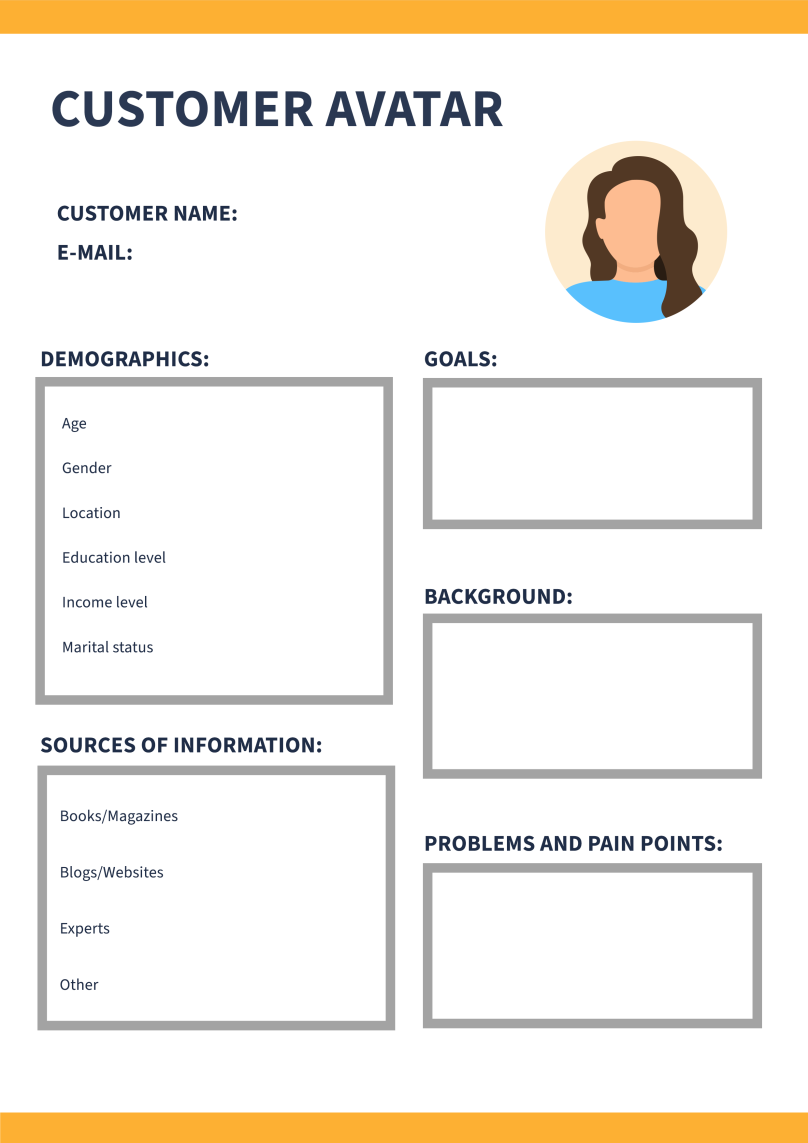Customer avatar

What is a customer avatar?
A customer avatar refers to a company's hypothetical "ideal customer" you want to attract and who will most likely need your product or service. A customer's avatar is often called a profile because it displays your audience's vision, with which the business better understands its customers and how to attract them.
Moving beyond definition and looking at the client avatar from a practical standpoint, it is:
-
A fictional character with a description of desires, problems, and motives that can be targeted when developing a product and advertising
-
A central part of the company's overall marketing strategy
-
Reflection of the target audience
-
A plan to attract a certain type of client based on analysis and research of the market
-
A scenario that maximizes the use of resources and budget when promoting the brand.
Why do you need a customer avatar?
Use a customer avatar to attract new customers! With a ready-made avatar, it is easier for a business to find a target audience and establish strong contact with it. You also get the opportunity to tailor your project and advertising offer to maximize benefits and profits.
So, having an ideal client avatar allows a business to understand the following:
-
Who will you sell your products or services to?
-
Why would these people buy from you?
-
How do you attract these people?
-
To accomplish this, what type of content do you need to create?
-
How do you realign your marketing strategy or sales plan to capture your customer avatar accurately?
-
What marketing and advertising channels are best used to promote a brand? After all, different customer avatars can even use different social networks, from Pinterest to Facebook!
-
What is the best voice tone to stick with the client?
Simply put, the customer avatar gives comprehensive information about the interaction with a specific type of buyer. As a result, marketing becomes several times more effective, spends fewer company resources, and brings more results. That is why the importance of an ideal customer avatar is undeniable.
What does a customer avatar include?

As a rule, you will need more than one client avatar. The wider your niche and business, the more avatars you should have. On average, the company has 5-6 avatars with a different set of characteristics and visions of the client, from which real buyers are correlated based on similarity and criteria.
Each customer avatar must include an inventory of the following eleven points, starting with demographic information:
-
Gender. Your product may be equally popular among both women and men. However, in the context of an avatar, you need to decide which gender of the client you will take and create separate avatars for each of them. Also, analyze who most often makes purchasing decisions - men or women. Does there seem to be a bias toward a certain gender? If there is one, there should be more avatars for the dominant gender.
-
Age. As a rule, all products are designed for a specific age group, but the reality could be that this group is not the one that makes the buying decision. In the case of children, parents always pay for their children's purchases. So, the avatar of your client is a parent, not a child. You can also additionally register your marital status.
-
Location. Understanding where your potential customer lives will help you focus your sales in a specific region or city. For example, the Waitrose brand opens stores mainly in small towns in the UK, positioning itself as "environmentally friendly and green."
-
Level of education. Knowing your client's educational background helps to determine precisely how they process information, whether they are guided by logic or emotions, whether they pay attention to statistics, expert opinion, etc.
-
Income. The critical point in the description of the client's avatar is that they determine the optimal cost of your products. For example, if a customer earns $100 a month, it would be unreasonable to ask that they pay $50 for a toothbrush.
-
Profession. This point is crucial for the B2B sector since you are more likely to be able to enter into cooperation with companies of certain specifics and industries. However, in the B2C sector, this is important too: this way, you will understand which promotions your client is more susceptible to, their daily activities, and their way of thinking.
-
Interests (hobbies). This information will help you determine what language is easiest to communicate with your client and how to engage them. From hobbies to favorite music, TV shows, and movies, everything is taken into account. The main thing in regards to this is understanding what can bring you closer to the target audience and how this can be played in the product's design or advertising.
-
Motivation. What makes your target client get out of bed in the morning and go to work? Values, landmarks, ideology, dreams, and aspirations - everything matters because people make buying decisions based on these factors.
-
Trouble. This will determine your product's future value to potential customers. First, you must identify their difficulties and how they can be solved. Problems can range from the most insignificant (a mug of coffee burns your fingers until it cools down) to global and financial (having no passive income).
-
Reasons to buy. Why should a customer buy your solution to their problem? It could be cost, quality, convenience, functionality, localization, customer service, or recognition. Knowing this will give you a better understanding of what triggers to use and how to persuade the customer to purchase.
-
Buying habits. It would be best to analyze a customer's previous and daily purchases. Which brand do they buy most often? Are they regular customers? What is their preferred method of delivery? How do they use similar products in everyday life? This also includes the avatar's most common objections. What usually prevents them from purchasing, and how to avoid this?
How to create a customer avatar

Defining your customer avatar and filling in the items discussed above occur in several stages. First, note that you should not try to "squeeze" into one avatar all the characteristics you see in your customers into one avatar. It is better to have multiple avatars, but they must be precise in what they convey.
Step 1. Name your avatar
Give your client a name and immediately specify who that person is. For example, Stephanie, the owner of a coffee shop, is looking for a way to improve the taste and appeal of her coffee to make people prefer her coffee shop over the one across the street. So you immediately form the basis of your avatar, and it will be easier to develop it in the future. Also, thanks to this "name," you can easily remember what a particular avatar includes. And easily refer to it in marketing plans and discussions, using a simple "advertisement for coffee shop owner Stephanie."
Similarly, you can name several avatars and gradually bring them to light in the following stages.
Step 2. Identify demographics
Demographic data includes gender, age, place of residence, income, marital status, hobbies, and your client's habits. This data will give you basic information about where and how to look for the avatar you need, how it looks, and its interests. The easiest way to collect demographic information is to use the search history of your customers, implement Big Data analysis based on artificial intelligence, or simply conduct online surveys among buyers. Don't be afraid to ask your customers directly! Use all the marketing tools available to make the customer's avatar as detailed and authentic as possible.
Specifically, at this step, you need to get answers to the following questions:
-
What is the gender and age of your avatar?
-
How much do they earn?
-
Where do they live?
-
What do they do? What is their educational background?
-
What is their marital status?
-
What do they do in their free time?
-
What social networks do they use?
The more precise details you can learn about your target customer, the more contact points you can establish with them, and the more ways you can influence them with the information you have.
Step 3. Identify psychographic data
Psychographic data includes the second half of the list of the previous section, namely values, motivations, reasons for buying, and buying habits. This information is most easily collected through surveys or interviews. You can also analyze websites and customer reviews. What questions are most often asked by your managers or written on social networks? What ideas are shared? For example, if you lead a group on Facebook, a social network popular with your avatar (which you found out in the previous step). You can determine the psychographic data just by flipping through the comments.
Step 4: Identify problems
Defining the goals your customers want to achieve using your product is a separate step. Your support team will help you collect such information - it is enough to analyze what requests and problems are most often addressed to you. Then, take away the pain points of your avatar that your product can close, and form on their basis affordable solutions.
This is important! Never rely solely on the opinions and answers of the customers' tete-a-tete and in surveys. Listening to customers is essential, but your task is to find deep problems, not superficial ones. The client can sometimes realize them, but not always. For example, the same Stephanie from a coffee shop may need to understand that the main reason people go to her competitors instead of her is a poorly placed street sign, not her coffee quality.
There are three ways to identify the client's pain points and problems:
-
Ask customers to complete a series of surveys that will separate superficial issues from deeper problems, so the topics that the client repeats most often are clearly bothering them.
-
Organize reviews by dividing them into groups according to common characteristics. This will make it easier to identify the specific issues customers will most likely address.
-
Analyze your support data. The more frequently a particular request occurs, the more important it is to fulfill it.
Also, consider why your customer avatar may not be interested in your product or service. What objections might they have when making a decision? How do you resolve them?
Negative customer avatar
Just as you describe your ideal customer, you can also describe an anti-customer that you should avoid when planning your marketing and product because it doesn't fall under your target audience in any way and will only consume your resources. It can also be customers from the past who have become a nightmare for your company. Or it could be impractical customers making long-term cooperation impossible for various reasons.
Creating a negative avatar at the very end is recommended to clarify positive avatars further and optimize ready-made strategies.
Customer avatar template

To make your work easier, you can be guided by the following checklist for creating a customer avatar checklist (make sure to add questions specific to your business or adjust the existing ones!):
I. Demographics
-
How can customers be called hypothetically?
-
What might they look like? (optional)
-
How old are the customers?
-
What is their gender?
-
What is their marital status?
-
Do they have children? How old are they?
-
Where do the customers live?
-
What do they do? Why?
-
What do they do in the evenings and weekends? What does their perfect free time look like?
-
How much do they earn per month and year?
-
What kind of education do they have?
-
What could they tell about themselves? (optional)
II. Goals and values
-
What are their main guidelines and values in life?
-
What goals do they want to achieve shortly?
-
What are their plans for the future?
-
What do they dream of?
-
What philosophical/social/political views on life do they hold? (optional)
III. Problems and pain points
-
What challenges are they trying to overcome? Which ones can you help with?
-
What obstacles do they regularly face in life?
-
What bothers and worries them?
What problem would they like to solve first?
IV. Sources of Information and means of influence
-
Where do they mostly get information?
-
What social networks do they use?
-
What books, magazines, and websites do they read?
-
Which experts and influencers do they trust?
-
What type of events do they attend?
V. Objections and the purchase process
-
Why might they reject your offer?
-
What doubts and fears can they have when buying?
-
What would convince them to make a favorable decision?
-
Is there anything you can do to earn their trust and make them regular customers?
Example of the customer avatar

For example, let's answer the key questions of the template (customer avatar questions) provided above.
I. Name: Stephanie Frisby
Age: 36 Years
Gender: Female
Residence: New York, USA
Level of Education: MBA in Digital Marketing (digital marketer)
Profession: coffee shop owner
Annual income level: $265,000
Marital status: single, no children
II. Goal: to attract more customers to the coffee shop, to turn the coffee house into a chain
Values: high-quality drinks, positive emotions, delicious coffee in the morning as part of the lifestyle
Dream: to open a second coffee shop in a more upscale neighborhood (building), travel more
About her: Stephanie is a workaholic, spends days and nights in her coffee shop, works with baristas, and serves customers, believing that doing so gives her business personality and helps to build relationships with customers. She has a dog which she sometimes brings with her. She enjoys diving, going to the beach, and doing yoga. Self-sufficient, bold, and confident, but frustrated with business due to a lack of experience and understanding of what to do next.
III. Problems and pain points: lack of Ty competent labor, need to expand the business, overwork, lack of sales funnel
IV. Books/magazines: books on self-help and marketing
Blogs/sites: www.digitalmarketer.com, Tripadvisor
Trusted experts: YouTube channel "How to make money on coffee," a personal blog by a chef.
V. Fears and objections: anxiety about the coffee shop closing; fear of admitting she cannot cope and trusting the outsourcing company; concern about losing money.
An effective way to remove objections: present successful cases of a company, similar to the case of Stephanie; suggest partial payment for services based on outsourcing results; explain through storytelling that without the help of your company, the coffee shop will likely stagnate and eventually close.
Ideal customer avatar worksheet
Here is a worksheet you can print and fill out (customer avatar worksheet):

Conclusion
Creating a customer avatar is a painstaking but enjoyable process that will help your company flesh out your marketing strategy and refine your product. Use all the tools and resources you have to gather as much information about your customers as possible, then categorize them and select a specific avatar from each category. Make sure you regularly update and keep them relevant as your business evolves and your target audience changes!























